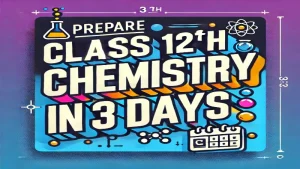Haloalkanes and Haloarenes MCQ Questions With Answers PDF. This course will help students in preparing MCQ’s for competitive exams like NEET , JEE Main, WBJEE and other competitive exams through various mock tests.
Alkyl halides are prepared by the free radical halogenation of alkanes, addition of halogen acids to alkenes, replacement of -OH group of alcohols with halogens using phosphorus halides, thionyl chloride or halogen acids. Aryl halides are prepared by electrophilic substitution to arene. Fluorine and iodides are best prepared by halogen exchange method. These compounds find wide applications in industry as well as in day to day life. These compounds are generally used as solvents and as starting material for the synthesis of a large number of organic compounds.
Haloalkanes and Haloarenes MCQ Questions With Answers Practice Set 1- Free!
1) Arrange the following compounds in order of increasing dipole moment:
(I) Toluene
(II) m-dichlorobenzene
(III) o-dichlorobenzene
(IV) p-dichlorobenzene
A) I<IV<II<III
B) IV<I<II<III
C) IV<I<III<II
D) IV<II<I<III
2) Pure chloroform is prepared by
A) distilling chloral hydrate with aqueous sodium hydroxide.
B) heating ethanol with bleaching powder.
C) heating acetone with bleaching powder.
D) reducing carbon tetrachloride.
3) The reaction conditions leading to the best yields of C2H5Cl are:
A) C2H6(excess)+Cl2 +UV light −−−−−→
B) C2H6+Cl2 + room temperature dark−−−−−−−−−−→
C) C2H6+Cl2(excess) + UV light−−−−−→
D) C2H6+Cl2 + UV light−−−−−→
4) The Wurtz-Fittig reaction involves condensation of
A) two molecules of aryl halides.
B) one molecule of each of aryl-halide and alkyl-halide.
C) one molecule of each of aryl-halide and phenol.
D) two molecules of aralkyl-halides.
5) For the compounds CH3Cl,CH3Br,CH3I and CH3F, the correct order of increasing C-X bond length is:
A) CH3F<CH3Cl<CH3Br<CH3I
B) CH3F<CH3Br<CH3Cl<CH3I
C) CH3F<CH3I<CH3Br<CH3Cl
D) CH3Cl<CH3Br<CH3F<CH3I
6) The order of reactivity of the given haloalkanes towards nucleophile is:
A) RI>RBr>RCl
B) RCl>RBr>RI
C) RBr>RCl>RI
D) RBr>RI>RCl
7) AgNO3 does not give precipitate with chloroform because:
A) CHCl3 does not ionise in water.
B) CHCl3 is insoluble in water.
C) AgNO3 is insoluble in CHCl3.
D) CHCl3 is an organic compound.
8) Which of the following statements is wrong?
A) Ethyl chloride on reduction with Zn-Cu couple and alcohol gives ethane.
B) The reaction of methyl magnesium bromide with acetone gives butanol-2.
C) Alkyl halides follow the following reactivity sequence on reaction with alkenes. R−I>R−Br>R−Cl>R−I
D) C2H4Cl2 may exist in two isomeric forms.
9) The total number of acyclic isomers including the stereoisomers with the molecular formula C4H7Cl
A) 11
B) 12
C) 9
D) 10
10) The major product formed when 1,1,1 -trichloro- propane is treated with aqueous potassium hydroxide is:
A) Propyne
B) 1-Propanol
C) 2-Propanol
D) Propionic acid
11) Which one of the following reagents is not suitable for the elimination reaction Chloroethane to propene?
A) NaI/acetone
B) NaOEt/EtOH
C) NaOH/H2O
D) NaOH/H2O−EtOH
12) Among the following, the molecule with the lowest dipole moment is
A) CHCl3
B) CH3Cl
C) CH2Cl2
D) CCl4
13) Which chloride is least reactive with the hydrolysis point of view?
A) CH3Cl
B) CH3CH2Cl
C) (CH3)3CCl
D) CH2=CH−Cl
Answer
- [b] In p-dichlorobenzene, the two equal dipoles are in opposite direction, hence the molecule has zero dipole moment. In o- and m- dichlorobenzenes, the two dipoles are at 60∘ and 120∘ apart respectively, and thus according to parallelogram law offerees, the dipole moment of o-dichlorobenzene is much higher than that of m-isomer. Lastly, toluene with a +I group possesses little dipole moment. Thus the overall order is IV<I<II<III
- Correct Answer: A Solution :[a] Cl3CCH(OH)2+NaOH→CHCl3 +HCOONa+H2O
- Correct Answer: A
- Correct Answer: B Solution :[ b] Reaction between alkyl halide, aryl halide and sodium in presence of ether is known as Wurtz fitting reaction C6H5Cl+2Na+ClCH3→C6H5CH3+2NaCl
- Correct Answer: A [a] The correct order of increasing bond length is CH3F<CH3Cl<CH3Br<CH3I
- [a] For a given alkyl group, the order of reactivity is ←−−−−−−R−I>R−Br>R−Cl>R−F−−−−−−−−−increasing bond energy decreasing halogen reactivity. This order depends on the carbon-halogen bond energy; the carbon-fluorine bond energy is maximum and thus fluorides are least reactive while carbon-iodine bond energy is minimum hence iodides are most reactive
- [a] Since CHCl3 is covalent compound it does not produce Cl− ion in H2O, hence no white ppt is formed during reaction with AgNO3.
- b
- B
- D
- A
- D
- D
haloalkanes and haloarenes mcq with answers pdf
haloalkanes and haloarenes questions with answers pdf for neet
mcq on haloalkane and haloarene
haloalkanes multiple choice questions
haloalkanes and haloarenes mcq gneet
haloalkanes multiple choice questions pdf
haloalkanes and haloarenes iit jee questions pdf
mock test on haloalkanes and haloarenes
JEE Main & NEET Chemistry MCQ Question Bank
Studenthelp.in have largest best collection of mcq for practice and its free forever .We believes “The more you exercise the better you’ll be, the harder you train the great in you they’ll see.” chemistryup.in will go out of its way to make these study material the best on the internet. I hope you find it helpful. Don’t forget to share. Stay connected for more.
PLEASE LIKE OUR FACEBOOK PAGE and Free to share our post to your Friends.







